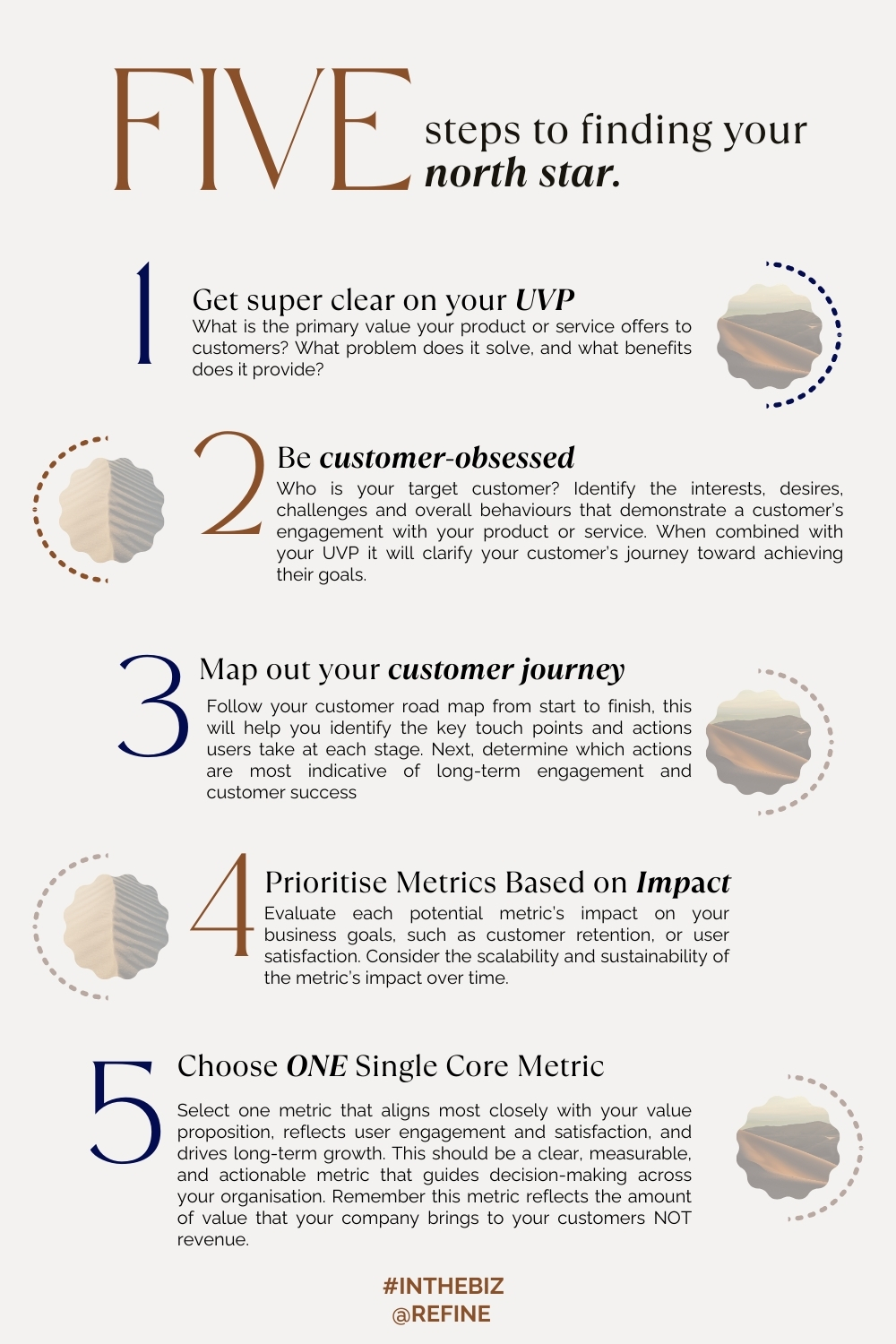Follow Your North Star Metric: The Key to Tracking Business Success
ENTREPRENEUR HUB / 18 SEPTEMBER 2023

Understanding the North Star Metric
A North Star Metric is a business metric that represents the most important goal or objective that it wants to achieve. It’s often used in the context of start-ups and product development to align the team and focus on what matters most for the business’s growth and success.
The idea is simple yet powerful. If your company brings more value to your customers, then the growth of your company has to go positive. The assumption is that if your customers receive a lot of value, they will stay longer, buy more, and refer more friends to your company. In other words, your business grows in every respect if your North Star Metric also grows.
However, not all metrics can qualify as a North Star.
North Star Metric Criteria
To be effective, it should meet the below 5 specific criteria:
1) Reflects Customer ‘Wins’ and Expresses the ‘Value’ Add to the Customer
Your NSM should align with the moment a customer achieves their desired outcome using your product/service. It should represent tangible value or meaningful interaction the customer experiences, transcending mere marketing-focused metrics.
2) Is Time-Bound and can be easily Measurable with Specific Actions:
It should be quantifiable, capturing specific actions or interactions that can be counted or measured. Measurement of the NSM should occur within a defined time frame (e.g., hourly, daily, weekly). This will make it easier to track and compare.
3) 100% Within Your Control
It should be a number that is affected by actions within the company’s control. It should exclude those that are influenced by external factors.
4) Directly Reflects Business Growth
Growth in the NSM should indicate proportional growth in the business, showcasing a genuine correlation between the two. Growth should occur frequently (e.g., daily, or weekly), offering immediate feedback on the company’s performance and alignment with customer success.
5) Touches Every Stage of your Funnel
Your NSM should resonate with all stages of the marketing funnel. This will enable every team member to contribute to its growth.
What is the difference between a North Star, Vision Statement and Mission Statement?
A North Star Metric, a Vision Statement, and a Mission Statement serve distinct purposes in guiding an organisation, product, or personal brand, and they vary in terms of scope, focus, and application.
Here’s a breakdown of their differences:

How to Find Your North Star Metric
Finding the right metric for your business involves understanding your core value proposition, identifying key customer behaviours, and aligning with your long-term goals.
Here are five steps to help you determine your own NSM:
When to Set Your North Star Metric
Creating your NSM is typically done during the strategic planning phase of a business or product development. It’s essential to establish this early in the planning process to ensure that your team is aligned with a central goal that drives decision-making and shapes the overall strategy.
Should You Include this KPI in Your Business Plan?
Yes, including the NSM in a business plan can be a valuable and insightful component.
Here are some reasons why:
- Clarity of Purpose: The NSM focuses on your business’s core objective, helping define what success looks like from a strategic viewpoint.
- Alignment: : It aligns your team, stakeholders, and investors around the most critical metric for your business’s success, guiding key decisions and resource allocation.
- Measurement and Tracking: With the NSM being measurable, it ensures you can track performance over time, demonstrating a commitment to data-driven decisions.
- Growth Strategy: It highlights the primary driver of growth, giving insight into how you’ll achieve your goals and scale your business.
- Investor Appeal: Investors value businesses that know their key drivers. Including the NSM shows you have a clear strategy for success and growth.
- Adaptation and Flexibility: While it represents a long-term objective, the NSM can be flexible, adapting to changing circumstances while keeping the business’s primary focus intact.
By incorporating the NSM into your plan, you show clarity, direction, and a results-oriented mindset, appealing to investors and helping steer the business toward sustained growth.
Examples of North Star Metrics
Here are 10 industry examples showcasing the power of a North Star Metric:
- Social Media: Daily Active Users (DAU)
- E-commerce: Average Order Value (AOV)
- Software as a Service (SaaS): Customer Retention Rate
- Health Tech: Patient Health Outcomes Improvement Rate
- Ride-Sharing: Rides per Active User per Month
- Gaming: Player Lifetime Value (PLV)
- Real Estate: Occupancy Rate (for rental properties)
- Food Delivery: Order Frequency per User
- Renewable Energy: Installed Capacity Growth Rate
- Education Technology (EdTech): Course Completion Rate
If you’re looking for further guidance in discovering your North Star, our consultations can help shape your roadmap to success. Schedule your initial consultation here







Read the Comments +